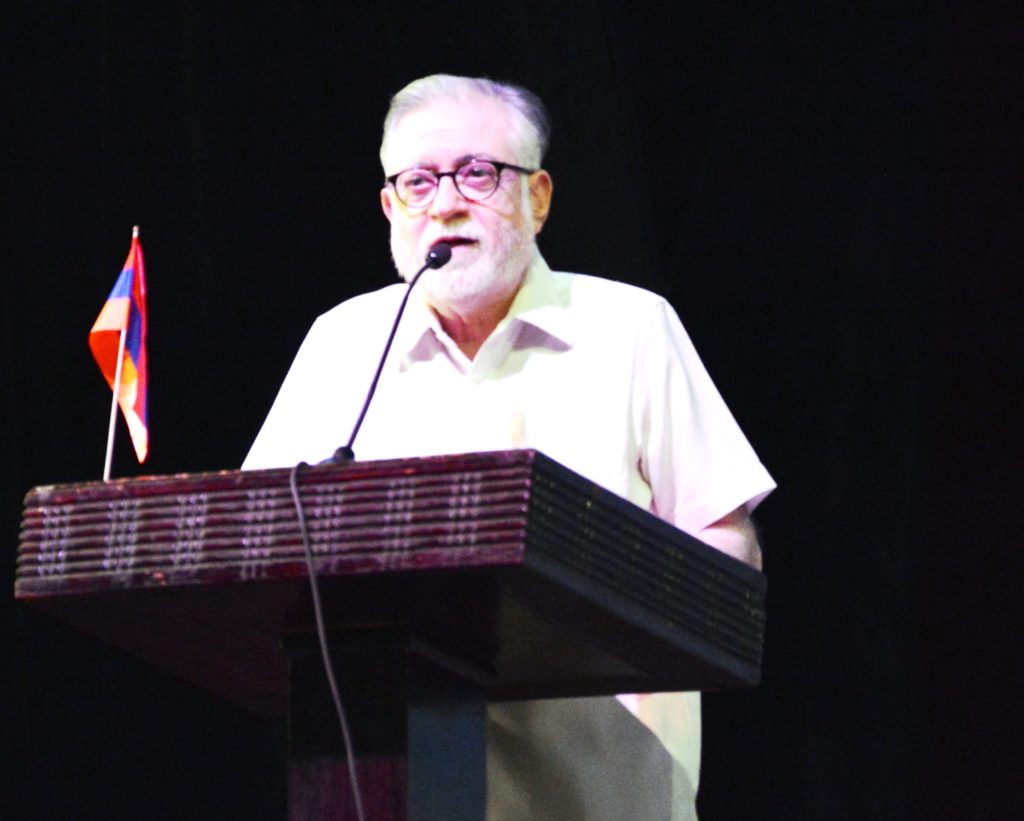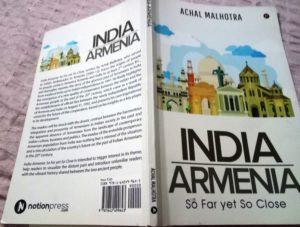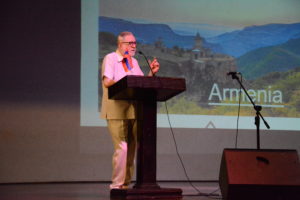“Madras, Calcutta were the cradle of Armenian Intellectual Activities”
Indians and Armenians were known to each other since at least the 4th century BC. In 149 BC two Indian princes migrated from Kanauj to Armenia where they set up a Hindu settlement

Today, 28th of May is a historical day for the Armenian people. On this day, in 1918, the Armenian National Committee declared Armenia an independent country, thus giving birth to the First Armenian Republic and marking the first revival of Armenian statehood. To mark this event Ambassador Achal Kumar Malhotra who served as the second Indian resident ambassador in the Republic of Armenia spoke to Aditi Bhaduri about the time spent there, and most importantly, about the millennia long dialogue that Indians and Armenians have had with each other. While India occupies a substantial place in the Armenian collective consciousness, and with good cause – there have been continuous Armenian settlements in India since at least the 16th century AD, and even earlier, and the first Armenian constitution was drafted on Indian soil – Indians know little about Armenia. In order to plug this gap and to encourage scholars to delve into the fascinating history of Indo-Armenian interactions and relations, Ambassador Malhotra has recently authored a book ‘India – Armenia: So Far yet So Close’.
Excerpts from the interview:
When were the first recorded interactions between Indians and Armenians?
There is some literary evidence from which we can draw some inferences that Indians and Armenians were known to each other since at least the 4th century BC. Armenians had accompanied Alexander the Great on his adventures to India and the Greek historian Xenophen had written a document Cyropedia, where he makes some references from which we can conclude that Armenians were familiar with Indians because King Cyrus wanted Armenians to accompany their envoy to India and to mediate because they wanted some financial assistance. But these are bits and pieces of information are available going back to the 4th century B.C.

Then there is literary evidence available – ‘History of Taron’ recorded by an Armenian of Syrian origin called Zenob who lived in 4th century AD, about Indians, to be precise Hindus, establishing their settlements in Armenia. In 149 BC, according to this document, two Indian princes – Gisneh and Demeter – had migrated with their families and retinue from a place called Kanauj and travelled all the way to the Armenian kingdom where they were accorded a very royal welcome and were gifted land. They settled down there, built their own temples, worshipped their own gods, and for almost the next 450 years lived in peaceful coexistence with the Armenians in a place they called Veeshap. Now it is important to understand that pre-Christian Armenians, who are today called pagans, also worshipped and followed rituals which had similarities with the Hindus, so there was religious compatibility and most Armenians did not perceive any kind of religious threat from Hindus.
However, all reference to Hindus vanish from Armenians annals from the fourth century onwards. What could be the reason? In 301 AD the then King of Armenia converted to Christianity and he decided to convert en masse full population to Christianity. In fact Armenia was the first country to declare Christianity its state religion. The historian Zenob [was] an eye witness to Christianization of Armenia has left behind very graphic descriptions about the battles that were waged between the Armenian king and the non-Christian Armenians who resisted the conversions and the Hindus and the latter were finally neutralized. So that was a defining moment between Hindu and Armenian interaction.
My inference about why Hindus are not referred to anymore after the 4th century is that either they converted or were absorbed, and also the records kept in many of these pagan temples were destroyed in this iconoclastic process of transition from pagan Armenians to Christian Armenians. Armenian scholars express dismay that they don’t have access to such documents anymore.
Armenia is a landlocked country and the terrain is not friendly. So when and how did they land up in India?
This is again one of those things that we will probably never know the origins about. There is this tale of a certain Thomas of Cana landing up in the Malabar Coast in the 8th century AD, that is 700 years before Vasco da Gama arrived in India. He settled down and began a business. He is credited with being a shrewd businessman and also a diplomat and began the settlement of Armenians. The Silk Route also played an important role as there was a lot of trade going on along it between Indians and Armenians, via Central Asia, Iran, Afghanistan. So it was a to and fro traffic. As far as the settlements are concerned, what I have gathered through the different narratives, documents, and interactions, [is that] it was during the Mughal period in the 16th century that the Armenians began to settle down in India in palpable numbers. They settled down in Agra to begin with, then [in] some neighbouring cities and then gradually began to spread across the rest of India. In fact Emperor Akbar is said to have been a great patron of Armenians. It is said that one of his Christian wives was Armenian. Now you must understand that trade was the motivating factor and the Mughal Empire helped to facilitate their arrival and settlements here because most of these Armenians had a base in Persia and could speak Persian. Many Armenians served in the royal court and were part of Akbar’s army and his doctors. It probably also could be that Akbar wanted to build this image of himself as a tolerant secular ruler who wanted to establish a new religion and so patronised them.

Yet another wave of Armenians came from New Julfa town in Ispahan district in Iran. This town was established by Shah Abbas of Iran in early 17th century and it is said that he ordered all the Armenian population of a particular village that was known as Juka or Julfa, which is now a part of Nakhichevan, an autonomous part of Azerbaijan, to move out from, because that was close to the Ottoman empire, so probably he wanted to fortify it. These people moved into India.
The fourth wave of Armenian migration to India, as we know it, occurred during the East India Company during the British period. Many Armenians from different fields came and settled down and pursued myriad professions as also of course trade. That is how Armenians came to be in India.
There are some allegations that Armenians facilitated British colonisation of India.
I have seen such reports but it is important to understand events in their proper context and perspective. If you see it from the Armenian perspective and the circumstances under which they were functioning, Armenians were basically traders but also had other professions. There were intellectuals too but they were small in numbers. They did not have the support of any state, like the East India Company had, for instance. At no point of time, during their stay in India, did the Armenians have any political aspirations or ambitions. Now what happened was that by the time the East India Company (EIC) established their first factory here, in 1608 if I am not mistaken, the Armenians were well settled here – they were in the good books of the Mughals, they were doing business, and they were prosperous. So from the British point of view they could sense that there was no need to use force against them, it was more useful to befriend them and Christianity must have been a binding factor. So much so that in 1688 the Armenians entered into a formal agreement with the EIC, under which they were granted many privileges in terms of doing business, in terms of owning land, in terms of getting residency in British colonies, they were even allowed to construct their own churches. It was all very well spelt out. In those circumstances, they may well have helped the British in some ways, like for instance, serving in the army but they certainly did not have the paraphernalia to help them colonise India as such.
What led to the outmigration of Armenians from India?
They [the Armenians] came with the Mughals initially in small numbers and then they multiplied under Mughal rule and then by the time of the British they were well settled here. However, even at the best, there were never more than 30,000 Armenians here. They were engaged in different trades.
Their first journal, which was printed and published in Armenian, was published in Chennai – the Azdarar. They built their churches, in 1838 they built their famous school – The Armenian College and Philanthropic Society in Kolkata – which is functioning till date. We have to understand that in the absence of a proper homeland the Armenians have been scattered all over the world – they were persecuted by the Ottoman Empire, by the Persian Empire and by the Russian Empire. That entire region – the South Caucases which is between the Caspian Sea and the Black Sea at one end and the South Causases mountain range – was subjected to subjugation by the Turks, the Iranians, and the Russians. The most brutal was of course the genocide of the Armenians in the 20th century by the Turks. Armenians are today three million in the diaspora compared to three million Armenians resident inside Armenia today.

However, in the diaspora they had a homeland state in their imagination and they drew up plans as to what kind of a state that should be. In the course of time they drew up a constitution for their much longed for state which they hoped would materialise some day, and that constitution was also drafted in India, in Chennai. Which reflects very well on India for giving them a safe and secure home where they could safely engage in such an exercise, at a time when they were being persecuted in so many other places. In fact, India – Calcutta and Madras in particular – was the cradle of Armenian intellectual activities.
The community produced those like the Sufi saint like Sarmad, who is buried in the complex of the Jamma Masjid here in Delhi and classical singers like Gauhar Jan
In the 20th century when India’s independent movement began to gain momentum, the Armenian community also became slightly restless because they had no clarity about their status in future independent India. So they made a petition to the British in which they raised these questions. The prompt response they were given was that there would be no separate provision for them but they would be treated at par as with other British subjects after independence. The Armenians were not too happy with this response because they wanted to know what would happen with those who were not British subjects. In turn they were asked to start their process of naturalisation. So, community leaders began to talk in discouraging terms. One of their historians Mesrob Jacob Seth, who died in 1934, said that Armenians indeed had a glorious past in India but was not sure their future here would be so. I wish he had lived for some more years. In short, I would say it was a misreading of the evolving situation in India which discouraged Armenians to stay on and slowly they started migrating out to greener pastures – like Australia, New Zealand, and so on.
Outmigration was a wilful move, and not because of any ethnic cleansing or persecution, or even any communal pressure here. It was just insecurity, aided by the many predictions done at that time that India would not hold on, and would collapse soon after gaining independence. Nevertheless, we can see that even today, with only 100 or 200 members of the community here now, all their symbols, their properties, like their churches, their schools, have remain untouched and intact. They were business minded and I think had they stayed on they would have done well, just like the Parsis have, for instance.
Tell us about your experience in Armenia.
I served in independent Armenia from 2009-2012. I discovered the reference to the Hindu settlements there and I found the lack of awareness about the age old interactions between the peoples of our two countries. And then I slowly started discovering things. For example I went to their Institute for Ancient Manuscripts and there I discovered a fan-shaped manuscript of Tamil language on palm leaves. I asked them how did it get there, had someone studied it, and they had no idea. Then I saw something written in Persian about the Hindu religion. Then I realised that Armenians till now follow some practices like animal sacrifice to appease and as thanksgiving. So I decided to join the dots so that a clear pattern emerges. I delved some more into the literature and history and tried to put things in one place in this book – ‘India – Armenia: So Far yet So Close.’.
When I realised how rich the history of Indo-Armenian interactions has been through millennia, and at the same time how little aware the people were, and how little people to people interaction there was currently, I decided to put it all down, to generate awareness and interest in the subject. That is how the idea of the book germinated in me.
Of course the book is not exhaustive but it provides a clue for others to follow on later if they wish to. My book is not an academic one, more of a popular history, easy to follow, and reaches out to a wide audience. And, of course, it is a document.
Armenians and Indians share many cultural traits. How does India figure in their imagination?
Well, [for] long years Armenia was part of the USSR till 1991. So when India became independent there could not be any direct interaction with Armenia, it all had to be routed through Moscow. Bollywood was one institution which was very popular with almost all Soviets and I found that out when I was posted there. I found a generation which was very taken in with Raj Kapoor and then I found another generation which went gaga over [actor] Mithun Chakraborty. The newer generation of course had its own preferences for John Abraham and Shahruk Khan and so on. Also during the Soviet period Indology was promoted and India was seen and shown in a very positive light, as a rich civilization and culture. People were well educated so they had their ideas about India. However, now with the advent of the cable TV and the internet, they get information about India from here and there, often distorted.
Also over the past couple of years the Armenians have liberalised their visa policy and unfortunately we have these cheats who have taken advantage of this to take people promising them jobs, and many have not come back and are working there in petrol pumps and was contrary to the image India has as an IT super power. And that created a little bit of bad taste, but then they realised this was not what India was about.
Overall there is a great deal of goodwill for India. Indians are liked there. An India-Armenian Cultural centre has opened up which is trying to forge close ties between the two countries. There are about 800 Indian students there, mostly studying in the Yerevan Medical University.
Tell us about current India-Armenia relations and bilateral ties.
The modern phase of Indo-Armenian relations began in the 1990s, when Armenia became independent in 1991. WE established diplomatic relations in 1992 but then for a long time the entire Caucasian region did not figure on India’s radar. Our focus was on Russia and Central Asia. But we have gradually been building up relations between our countries continuously. We have had till now three presidential and two vice presidential visits from India, and we have institutional mechanisms like foreign office consultations, central governmental meetings and so on.
In short today as far as Armenia is concerned our political understanding is excellent. We have complete understanding of issues of bilateral and regional dimensions and converging views.
 We fully appreciate their position on their conflict with Azerbaijan on the issue of the enclave of Nagorny Karabakh and they have full understanding of our position on Kashmir. Armenia does not have any diplomatic relations with Pakistan, by the way. Pakistan does not recognise Armenia, it is obliged to Azerbaijan.
We fully appreciate their position on their conflict with Azerbaijan on the issue of the enclave of Nagorny Karabakh and they have full understanding of our position on Kashmir. Armenia does not have any diplomatic relations with Pakistan, by the way. Pakistan does not recognise Armenia, it is obliged to Azerbaijan.
They support our candidature in the expanded UN Security Council, whenever it is expanded, as a permanent member. It is difficult to identify an issue which can be termed as a bilateral irritant. There is absolutely none.
However, this political understanding is not reflected in our bilateral trade and economic relations. Our bilateral trade is miniscule, balance is in our favour, there is hardly any investment.
What can Armenia offer us?
First, each country, irrespective of size and population, has one full vote in the UN. So when India is aspiring to become a global player you need support from every side. At least you don’t have adversaries.
Armenia is rich in some minerals like gold, copper, uranium, and excellent in diamond cutting. They are good in the seismic sciences, in IT, and are members of the Eurasian Economic Community and we are negotiating a FTA with them. Armenia also has a comprehensive partnership agreement with the European Union and also has set up special economic zones. So we can think of using Armenia as a platform for having duty free access to Europe, America. We can develop tourism together. So we can think of synergising our strengths.
Hi Achal:
A very nice write up on Armenia. This is one of the few countries that I haven’t been able to visit so far. There are many people of Armenian origin here in Pittsburgh too. I am bit surprised that you didn’t mention Mother Theresa’s name specifically? She was an Armenian nun? Isn’t it?
Thanks Murli . You must visit Armenia either on a stand alone visit or in combination with Georgia and Azerbaijan.
Mother Teresa was NOT of Armenian origin. Hence no reference to her. To best of My knowledge she was of ALBANIAN origin .
If you or your friends are interested in Armenia , you may consider buying my recent book India Armenia : So Far Yet So Close , available at Amazon ,FLIPKART etc.